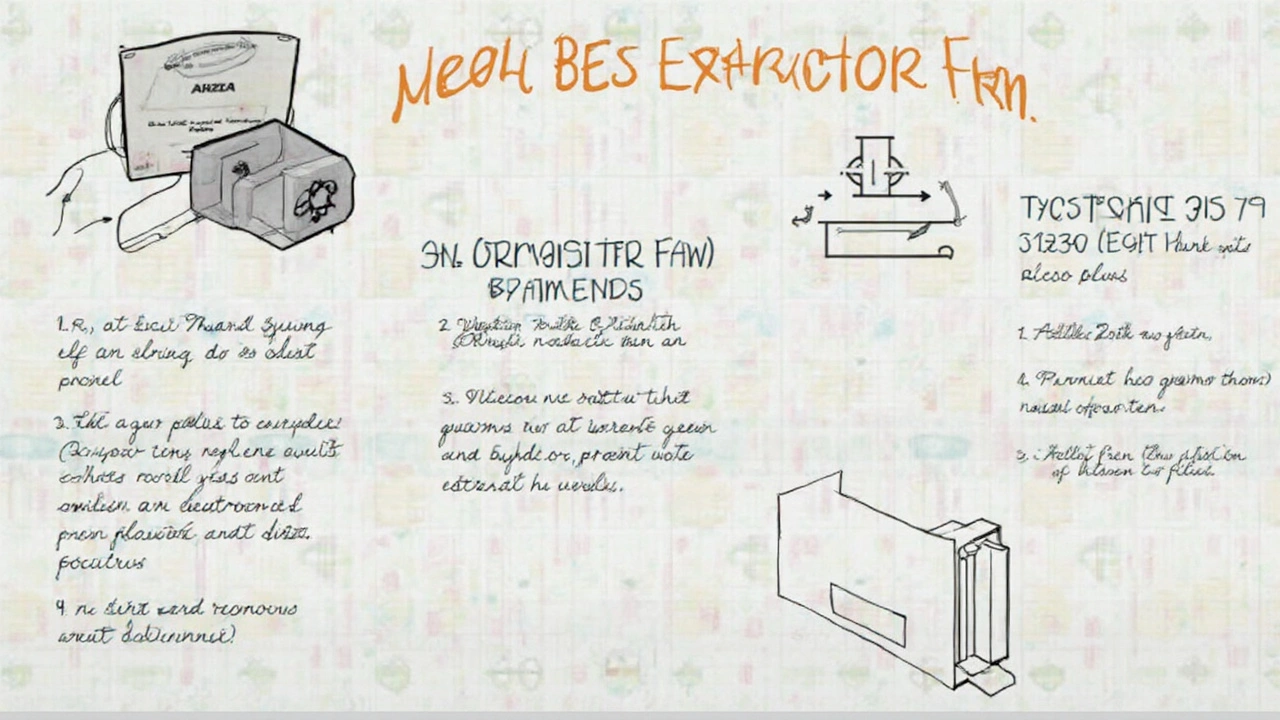
- 26 Jun 2025
- Gideon Thornton
- 0
You’ve stuffed towels under the door, cracked every window, yet your bathroom still feels like a sauna long after a hot shower. Then, mildew starts to creep onto your grout, and the walls get that musty smell. That’s the moment you realize: you need an extractor fan. But who do you call first? Most people instinctively ring a plumber. Does that make sense, or are you barking up the wrong tree?
The Plumber vs. Electrician Dilemma: Who Really Installs Extractor Fans?
Everyone knows plumbers fix leaks, unblock drains, and deal with toilets that refuse to flush. But extractor fans? That’s a line of work that straddles two worlds: water and wires. Plumbers deal with bathrooms all the time, so you’d think fitting an extractor fan would make sense, right? But here’s where things get a bit muddy.
Installing an extractor fan isn’t just about drilling a hole through the wall or ceiling. There are different jobs rolled into one: making a hole for the fan, connecting the ducting, sealing the fan to prevent leaks, and—most critically—wiring it safely to the mains electricity. That last part can be a sticking point. Not all plumbers are trained and certified to work with electrical wiring, especially in what’s called a ‘wet zone’ (like bathrooms, where regulations get strict).
That’s not to say some plumbers aren’t handier than others. In the UK, for example, the standards are crystal clear: any electrical installation in a bathroom has to be done by someone listed as ‘competent’ and who knows their way around Part P of the Building Regulations. If your plumber is also Part P qualified (and can prove it), then yes—they can legally and safely wire in your extractor fan. If not, they’ll need to partner with an electrician or leave the electrical work for someone else. The same goes in Australia, New Zealand, or the US—wiring always needs the proper license. So before you book anyone, ask: “Are you certified to wire this in?”
Some big-name plumbing companies employ multiskilled tradespeople—plumber-electricians—who make life easy by handling the whole job. But if your friendly local plumber isn’t one of those, they’ll handle the pipework, ducting, and holes, but call in an electrician for the hocus-pocus of wiring. It’s teamwork, even if it means scheduling two visits. Always check their credentials, especially when bathrooms and electricity mix. You don’t want to risk voiding your home insurance over a shortcut.
One more thing: there are plug-in extractor fans, but they’re rare, clunky-looking, and nowhere near as efficient as hardwired ones. Ninety-nine percent of decent extractor fans will need wiring. Even the silent or humidity-sensing models need a safe connection and can’t simply run off a power socket in the wall. Safety is king.

What Makes Extractor Fan Installation Tricky?
It sounds easy: pick a spot, drill, pop in a fan, and you’re done. But the reality’s a bit more cursed. Bathrooms, kitchens, and laundry rooms are all filled with invisible hurdles. Let’s break down the dragons you’ll face when installing an extractor fan, and why hiring the right person matters.
First hurdle: walls and ceilings aren’t all created equal. Solid brick? Old plasterboard? Metal joists? You can hit unexpected things behind your tiles: pipes, cables, or even mysterious old air vents nobody told you about. A plumber’s experience with bathroom layouts can be helpful for negotiating tricky spaces, but they might not be as skilled as an electrician in finding safe cable routes through walls and ceilings.
Then there’s the issue of positioning. Extractor fans need to be placed where they’ll do the most good—typically as far from the door and as close to the moisture source as possible. But building codes set minimum distances from showers, baths, and other electrics. Get it wrong, and the thing won’t pull enough steam from your mirrors. Plumbers know their way around a bathroom, but the best ones will map out the right spot and understand how air moves—vital for preventing future mold invasions.
Remember the ductwork: every extractor fan needs an exit, either out through a wall or up to the roof. If you live in a block of flats or a house full of hidden pipes, finding the cleanest exit can get complicated fast. Cutting holes in outside walls or ceilings is messy, noisy, and needs the right tools—usually a core drill, which not every plumber owns. Seasoned plumbers will have these or know someone who does, but cowboys can make a mess of your brickwork or ruin your waterproofing, leading to future leaks and repairs.
And then there’s the electrical work. UK rules (and similar ones elsewhere) state extractor fans in bathrooms must be on a safe circuit, protected by an RCD (a lifesaving device that prevents fatal electric shocks). Wiring has to be waterproof, the right thickness, and connected to the right part of your lighting or power circuit. If you want your fan to run on a timer, a humidity sensor, or to switch on with the light, the wiring gets even more complex. A certified electrician, or a plumber who’s qualified as one, will know this dance. Get it wrong, and you can end up with a dead fan—or worse, a fire hazard.
Finally, fitting a fan isn’t just a case of mounting it and walking away. The installer should seal around the fan to prevent moist air leaking into walls or ceilings. Poor sealing is one of the top reasons for hidden mold and rot. Professional bathroom fitters, plumbers, or electricians will always use the proper silicone, expanding foam, and vent covers. If they don’t, your ceiling may be quietly growing its own ecosystem in a few years.
- Always check your installer’s credentials—especially if they claim to do both plumbing and wiring.
- Ask about experience with extractor fans specifically; it’s a niche skill.
- If your job needs drilling through exterior brick, make sure your tradesperson has a core drill and knows how to use dust sheets. It gets messy.
- Good installers will show you how your fan works before leaving; ask questions before they pack up.
- Look for signs of poor work: loose fittings, gaps where steam escapes, noisy operation, or wiring that looks hastily done.

The Smart Approach: Getting the Best Extraction for Your Money
So, can plumber extractor fan jobs be done by the same person? Sometimes. But it rests on one big fact: legal, safe, top-quality installation. That means finding the right tradesperson (or persons) who actually know both sides. Relying on a good plumber who partners with a trusted electrician is just as reliable as hiring one multiskilled pro.
You’ll save yourself a world of headaches by remembering a few simple steps. Start by picking a fan with the right power (measured in liters per second, or L/s, in the UK, or cubic feet per minute, or CFM, in the US). Bathrooms, for example, need a minimum airflow rate—usually 15-25 L/s for a typical family bathroom. Kitchens might need more. Don’t fall for “silent” fans with low extraction rates if you hate foggy mirrors.
Think about features: do you want a humidity sensor that switches on automatically? A timer so the fan keeps running after you leave? A pull-cord for old-school control? Discuss these with your installer before buying the fan, so you don’t get a model they can’t wire up.
If you’re in a rental or listed property, ask your landlord or council about rules. Many flats and historic buildings have restrictions on drilling new holes through external walls or changing bathroom fixtures. Plumbers familiar with local regulations can steer you away from expensive mistakes.
Need to do a bit of DIY before the pro arrives? Keep the area clear, lay dust sheets, and be ready for noise. Some installations can take several hours, especially if there’s tiling, brick, or an awkward ceiling to tackle. And if you’ve got pets like I do (Whiskers hates the drill), warn the installer before they show up—so they don’t trip over a tail or freak out your cat.
Hot tip: after installation, run your fan regularly and clean any grills or filters at least twice a year. Steam, dust, and hair can clog up even the best extractor, making it noisy and useless. If your fan starts rattling, it’s usually just clogged. Unscrew the cover, clean it out, and you’re back in action—no need to call anyone (unless you want to, in which case, any good plumber can help you out).
Extractor fans are those backstage bathroom heroes nobody thinks about until they fail. Whether you call a plumber, an electrician, or that rare breed who does it all, remember: credentials and good questions matter more than job titles. Don’t roll the dice with someone who’s learning as they go. In the end, a properly installed fan isn’t just a box on the wall—it’s your defense against musty air, mildew, and that persistent puddle under the bath mat. Isn’t that worth doing right?

